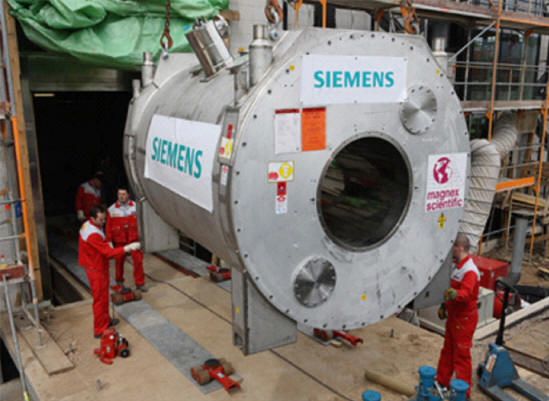|
|
|

A
9.4 Tesla electromagnet built for brain
research, about 200,000 times more powerful
than Earth's magnetic field. Credit: Siemens
press picture.
Electrodynamic Duo Part One
Feb 08, 2011
Magnetism and electricity
have been known since ancient times. More
recently, how the two forces connect has
prompted more interest.The Greeks were
familiar with magnetis lithos, or "Magnesian
stone" as early as 500 B.C.E. Magnesian stone,
from which the word "magnet" is derived, was
originally found on the coast of what is now
Turkey. Later, the magnetic rocks came to be
known as "lodestones" and were probably used as
compasses to guide ships since the eleventh
century.
Not much was known about how compasses worked
until the time of Sir William Gilbert, commonly
referred to as "the father of magnetism and
electricity" because of experiments leading to
the groundbreaking book, De Magnete in
1600. Gilbert was the first person to use terms
like “magnetic pole,” “electric force,” and
“electric attraction.” He also coined the word
"electricity" from the Greek word for amber,
elektron.
In 1820, Danish physicist Hans Christian Oersted
found that electric current flowing through a
wire deflected a compass needle, inspiring
electromagnetic theory. When he placed a
magnetic compass below an electric current, the
needle moved perpendicular to the wire.
A magnet is simply any object that possesses
magnetic properties. Primarily, that means two
poles known as "north-seeking" and
"south-seeking," which on separate magnets
attract each other. Like poles of different
magnets, on the other hand, repel each other in
the same way that opposite electric charges
attract or repel.
In the eighteenth century, C. A. Coulomb
discovered that the force between magnetic poles
could be described using the same inverse square
relationship as that between electric fields.
Just as with electricity, magnetism is directly
proportional to the strength of the combined
poles and inversely proportional to the square
of the distance between the poles. Also similar
to electricity, magnetism acting at a distance
is described as a "field of force" because it
has no known physical component.
"Magnetic flux" is a term that illustrates how
force appears to flow out of a magnet at one
pole and back into it at the other. This effect
can be seen in the patterns that form when iron
filings are sprinkled on a paper with a magnet
underneath it. The patterns are known as "lines
of induction." There is no physical flow, but
the lines of induction confirm descriptions of
magnetism. Lines of induction (magnetic field
lines) emanate from a magnet's north pole and
terminate at the south pole. The number of lines
per a given area indicates the field strength:
where the lines converge at the poles, the field
is large, while the field becomes progressively
weaker where the lines diverge.
The electrical basis for magnetism has been
verified down to the level of the electron.
Since an electron spins and has an electric
charge, it is often said to be "charge in
motion, which by definition results in a
magnetic field.
In 1825, Ampère demonstrated that a
current-carrying conductor exerts forces on a
magnet and that a magnet also exerts forces on a
current-carrying conductor. Michael Faraday and
Joseph Henry followed with their discoveries
that current can be generated in a conductor by
changing the magnetic field surrounding it.
So-called "electromagnetic induction," along
with the realization that electric currents
create magnetic fields, paved the way for both
the electric generator and the electric motor.
Further relationships between electricity and
magnetism were elucidated by James Clark
Maxwell. In particular, a changing electric
current in a conductor creates a changing
magnetic field around the conductor, thus
creating a changing electrical field.
Oscillating electric and magnetic fields (now
called "electromagnetic radiation") can
therefore become self-sustaining, like a wave
propagating through space. Also, since the
velocity of electromagnetic radiation is
identical with the velocity of light, light's
close connection with electricity and magnetism
was revealed.
Solid, liquid, and gas are the commonly
understood states of matter, although the
readers of these pages are aware that a fourth
state known as "plasma" exists. Plasma is
estimated to constitute 99 percent or more of
the Universe, and is distinctive because it
contains a large enough number of electrically
charged particles for its electrical properties
and behavior to be altered.
In a neutral gas, positive and negative charges
combine: the positive charges (protons) in the
atomic nuclei are surrounded by an equal number
of negatively charged electrons. The atoms are
electrically neutral. Gas becomes plasma when
heat or some other energy strips some electrons
off some of the atoms. A positive charge is left
on those atoms, while the detached negative
electrons move around. This results in an
electrically charged gas that is said to be
"ionized." When enough ions accumulate so that
the electrical characteristics of the gas are
affected, it is a plasma.
Irving Langmuir was first to use the term
"plasma" (referring to an ionized gas) in the
1920s. He noticed similarities in the structure
of electric discharges through mercury vapor.
Regions close to the walls in the glass
discharge chamber, or near the electrodes were
already called "sheaths." However, the ionized
material filling the discharge chamber had no
name, so Langmuir decided to call it "plasma."
Plasma was found to be an excellent electrical
conductor with behavioral laws all its own.
Stephen Smith
|
|
|
|
|
|
|
|
|
YouTube video, first glimpses of Episode Two in the "Symbols of an Alien Sky"
series.
|
|
|
|
|
|
|
Three ebooks in the Universe Electric series are
now available. Consistently
praised for easily understandable text and exquisite graphics.
|
|
|
|
|
|
|
|
|
|







